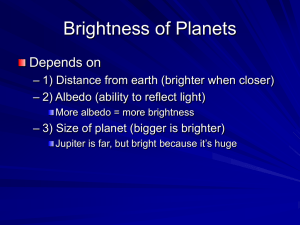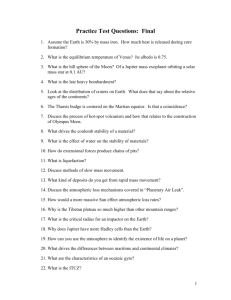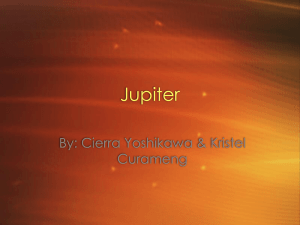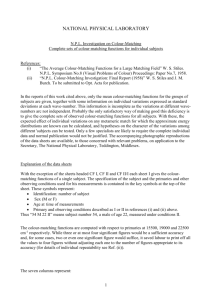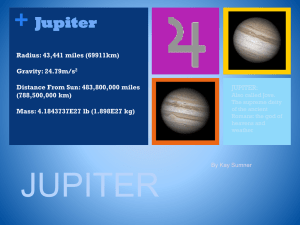The structure of Jupiter’s Great Red Spot from the
advertisement
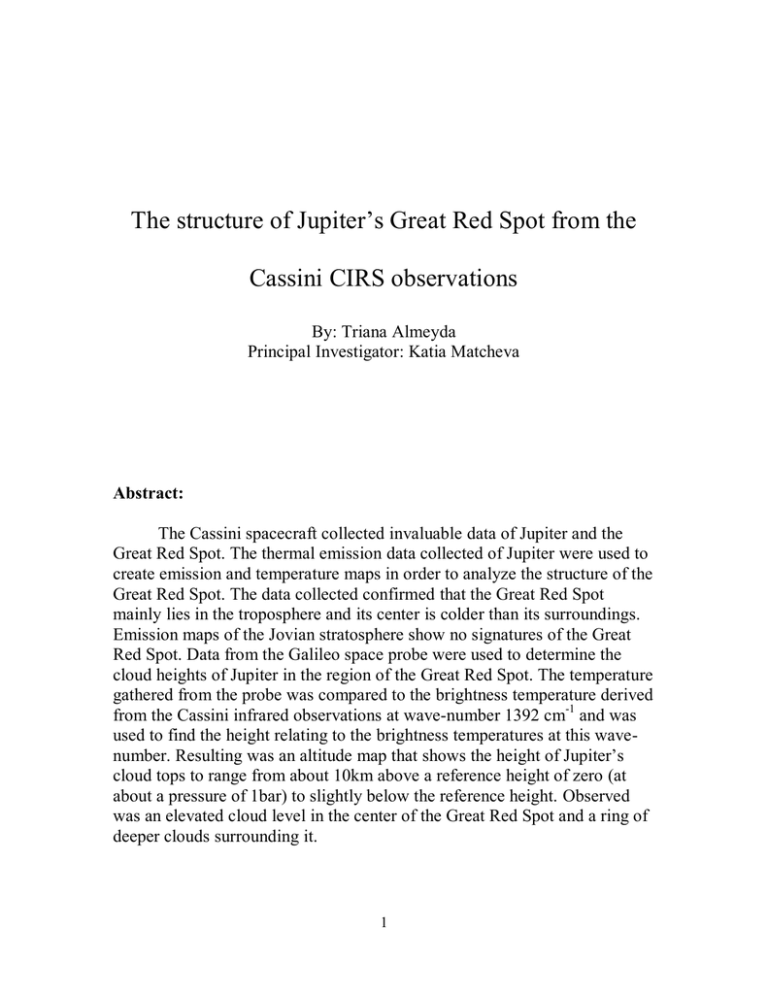
The structure of Jupiter’s Great Red Spot from the Cassini CIRS observations By: Triana Almeyda Principal Investigator: Katia Matcheva Abstract: The Cassini spacecraft collected invaluable data of Jupiter and the Great Red Spot. The thermal emission data collected of Jupiter were used to create emission and temperature maps in order to analyze the structure of the Great Red Spot. The data collected confirmed that the Great Red Spot mainly lies in the troposphere and its center is colder than its surroundings. Emission maps of the Jovian stratosphere show no signatures of the Great Red Spot. Data from the Galileo space probe were used to determine the cloud heights of Jupiter in the region of the Great Red Spot. The temperature gathered from the probe was compared to the brightness temperature derived from the Cassini infrared observations at wave-number 1392 cm-1 and was used to find the height relating to the brightness temperatures at this wavenumber. Resulting was an altitude map that shows the height of Jupiter’s cloud tops to range from about 10km above a reference height of zero (at about a pressure of 1bar) to slightly below the reference height. Observed was an elevated cloud level in the center of the Great Red Spot and a ring of deeper clouds surrounding it. 1 Introduction: The study of Jupiter’s atmosphere has been made possible through ground-based and spacecraft-based observations. From these observations we know that Jupiter is a gaseous planet composed of mostly hydrogen and helium. Some minor gases on Jupiter are methane, ammonia, and phosphine. The top three regions of the atmosphere of Jupiter are the thermosphere (the highest), the stratosphere, and the troposphere. In general, the temperature of Jupiter’s atmosphere decreases with height until the tropopause level (the boundary between the troposphere and the stratosphere) and then increases with height throughout the rest of the upper atmosphere. Jupiter’s most recognizable feature, the Great Red Spot (GRS), is a topic of great interest and is believed to reside in the troposphere. The GRS is an anti-cyclonic storm, which rotates counter-clockwise, that lies in one of Jupiter’s lighter color bands, called zones. The light colored zones are associated with the upwelling of air, whereas the darker colored bands are associated with the regions of down-welling air. Simon-Miller et al. [1] describe the GRS as a pancake that is tilted from NE to SW. The GRS is colder than its surrounding air and lies high in the troposphere. Models of Jupiter’s vertical temperature profile have been generated, but none on the GRS alone. This paper is focused on understanding the structure of the GRS. The data used for this project are the observations from the Cassini Composite Infrared Spectrometer (CIRS) of Jupiter, available through the Planetary Data System (PDS). The observations from Cassini’s CIRS instrument will be used to map the emission of Jupiter at different wavelengths. Each wave-number penetrates the atmosphere up to a different altitude, so 2 the maps that are created represent different heights and layers of the atmosphere. This is the key to develop the vertical profile cloud structure of the Great Red Spot. Focusing on the GRS’s location, the emission maps will be used to compare the emission from different altitudes from the atmosphere. The emission data will then be used to derive the brightness temperature. Then, brightness temperature maps can be created for each wave-number and used with the emission maps to analyze the cloud structure of the GRS. These results will be compared to other observations that have been published. Wave-number 1392 is important to this project because it probes deep into the atmosphere and is free of interference of constituents in the atmosphere, such as ammonia and phosphine, that affect the other wave-numbers in the mid-infrared part of the spectrum. Based on the validity of my observations compared with those that have been published, conclusions can be made about the cloud properties of the GRS. We hope to use the results to derive the temperature structure and the height of the top most cloud within the GRS. Method: The data used for this project were obtained from the Cassini spacecraft as it flew by Jupiter from December 2000 to January 2001. The CIRS instrument carried aboard the spacecraft collected infrared (IR) observations of Jupiter’s thermal emission using three focal planes (spectral range between 10 and 1429 cm-1). Focal planes 3 and 4 collected data in the mid-IR range (590 to 1429 cm-1). The planet was mapped in four observing runs of 60° N to 60° S latitude and 0 and 360° longitude resulting in four IR maps: ATMOS02 (A-D). Map A had the best spatial resolution (2.2° lat). All the data collected by CIRS during the Jupiter flyby are currently available through the PDS. 3 The data were extracted from the PDS by using the Vanilla software. This program allowed me to select the data that specifically applied to my research, such as the time of observation, the latitude and longitude range, the emission angle, and the spectral resolution. Using my mentor’s previous work on the depth of penetration of the mid-IR radiation in the atmosphere, I selected 15 wave-numbers that penetrate the atmosphere at different altitudes (pressure levels). Figure 1 shows a graph depicting the pressure level of the atmosphere that is penetrated from wave-number 590 to 1500 cm-1. A file was created of the extracted data for each wave-number. Each file contains the spacecraft event time, longitude, latitude, emission (units of Wcm-2sr-1(cm-1)-1), emission angle, and detector number. Figure 1. Pressure level corresponding to the penetration depth of thermal radiation at different wave-numbers in the atmosphere. Source: Matcheva et al. [2] 4 Once all the data were selected, a Fortran program was written to calculate the average of the emissions while re-gridding the data, to determine the average brightness temperature of the emission at each point, and to find the corresponding height. The data file of each wave-number consists of the emission at every point in the southern hemisphere from 0 to -60° latitude and a full rotation (0 to 360° longitude). The program averages emission data points within a 3 by 3 square that moves by 1 degree in latitude and longitude in order to re-grid the data throughout the entire southern hemisphere. This procedure results in a new equally spaced dataset with an improved signal-to-noise ratio. Next, the program uses the new average emission points to calculate the brightness temperature that corresponds to that emission of that particular data point. The formula used for the brightness temperature is , (1) where h is Plank’s constant, c is the speed of light, k is Boltzmann’s constant, ν is the wave-number, and emis is the average emission. The brightness temperature is in units of Kelvin. Finally, the last calculation in the program is to determine the height of the cloud levels using the emission at wave-number 1392 cm-1 and data from the Galileo probe that penetrated Jupiter’s atmosphere. This probe collected data such as temperature, pressure, and height among other things. By comparing the temperature measured by the Galileo probe and the brightness temperature derived using the Cassini data, I assigned a height to each value of brightness temperature and created a map corresponding to the altitude of the emission at wave-number 1392cm-1. After all the calculations were completed, the 5 program output files containing the re-gridded longitude and latitude, the average emission, and the average brightness temperature. The 1392cm-1 wave-number included an extra column corresponding to atmospheric height. The new files created for each selected wave-number were used to plot contour maps representing emission and maps representing temperature. Results: Emission and temperature maps were created of the southern hemisphere at each selected wave-number. Also, emission and temperature maps were created that focus mainly on the GRS. One height plot was created as well. A few select maps are presented below. Figure 2 represents the emission and temperature of the southern hemisphere of Jupiter at the 1392cm-1 wave-number. As one can see, both the emission and temperature maps resemble the banded structure of Jupiter. The dark colored bands of this map represent the zones (cooler temperature), and the light color bands represent the belts (warmer temperature). Also, the GRS is visible on these maps; it is the dark oval seen at approximately -20° latitude and 50° longitude. As mentioned before this wave-number penetrates as deep as the 1200mbar pressure into the atmosphere, so this is the deepest representation of the GRS in the mid-IR. The blank spots on the maps are the regions of the planet with no observations. Because both the emission and temperature maps look very similar, it is more convenient for this paper to show the temperature maps only from this point on. 6 Figure 2. Maps of the southern hemisphere of Jupiter at 1392cm-1, the top map represents emission and the bottom is the corresponding brightness temperature. 7 Figure 3 shows the temperature of the GRS at 1392 cm-1. Figures 4 and 5 are representative of the wave-number 600 cm-1. These maps represent the atmosphere at a pressure level of about 200mbar, which is high in the troposphere. Overall these maps show temperatures cooler than the maps at 1392cm-1. Although this emission is coming from higher in the atmosphere the GRS is still noticeable with a temperature difference of about 10 K. Figure 3. Temperature map of 1392 cm-1 wave-number of the GRS. 8 Figure 4. Temperature map of Southern Hemisphere of wave-number 600 cm-1. Figure 5. Map of GRS of wave-number 600 cm-1. 9 Figures 6 and 7 show the brightness temperature maps at wave-number 1305cm-1. This wave-number penetrates the stratosphere region of the atmosphere which is at approximately 4mbar. At this wave-number the bands of Jupiter are less noticeable and the GRS is nowhere to be seen. Also, both figures have higher temperatures present compared to the previous two wave-number maps, reflecting the relative warmth of the stratosphere. Figure 6. Temperature map at wave-number 1305 cm-1 representing the Southern Hemisphere. 10 Figure 7. Map at wave-number 1305 cm-1 representing the GRS. Figure 8 is a 3-dimesional plot of the GRS at wave-number 1392 cm-1. This plot is significant because it shows the deepest layer of the atmosphere that can be penetrated. It represents the topography of the thick top layer of clouds in Jupiter’s atmosphere. Figure 8. Height of the cloud structure using wave-number 1392 cm-1. 11 Discussion and Conclusion: Based on the maps produced of the 15 wave-numbers, a basic structure of the GRS can be determined. After comparing and analyzing the emission and temperature plots, we note that the GRS is only distinguishable on about half of the plotted wavenumbers. The wave-numbers at which the GRS is visible correspond to the pressure levels of 100mbar to 1100mbar; this is the tropospheric layer of the atmosphere. Our observation supports previously published results that the GRS is located in the troposphere and does not extend to the stratosphere. While examining the vertical variation of temperature of the GRS and the atmosphere above it, we found that this temperature profile shared similarities to the previously observed temperature profile of Jupiter. According to data analyses from the Voyager and Galileo spacecrafts, the temperature of Jupiter’s atmosphere decreases with height until the tropopause, and then the temperature increases with height throughout the rest of the atmosphere [2, 3]. Our results of the temperature profile of the GRS and the atmosphere above it show a similar decrease in temperature until the tropopause and then a rise in temperature. Although the GRS is technically colder and higher in the atmosphere than its surrounding regions, it stills follows the basic temperature profile as does the rest of Jupiter. Low (high) brightness temperature corresponds to emission from higher (lower) altitudes [2]. The maps shown in Figures 3 and 8 demonstrate that this is true, because the clouds at the center of the GRS have colder brightness temperature and lie at a higher altitude than the surrounding clouds. Analyses of Figure 8 showed that the height of the 12 GRS clouds on Jupiter varies between 10 km to -2 km with respect to the 1 bar pressure level. Although these observations have led to a vast amount of knowledge and understanding of Jupiter and its Great Red Spot, much is still yet to be learned. For instance, what gives the GRS its red color? What is the chemical composition of the GRS’s cloud layers? How thick are the clouds? Is the chemical structure of the GRS consistent with the atmosphere of Jupiter? With the myriad of data available we are able to continue research to provide theories and models of Jupiter. However, until there is a mission primarily focused on this giant red planet, much of Jupiter and its atmosphere will remain a mystery. Acknowledgments: I would like to thank the University of Florida’s Physics REU for accepting me into the program and NSF for funding the program. Also, I would like to thank my advisor Katia Matcheva for including me in her research and providing background knowledge. Finally, thank you to Selman Hershfield, Kevin Ingersent, and Christine Scanlon for their organization, help, and support. References: [1] A.A. Simon-Miller et al., Icarus. 158, 249 (2002). [2] K.I. Matcheva, B.J. Conrath, P.J. Gierasch, and F.M. Flasar, Icarus. 179, 432 (2005). [3] T. Encrenaz, The Astron. Astrophys. Rev. 9, 171 (1999). [4] P.V. Sada, R.F. Beebe, and B.J. Conrath, Icarus. 119, 311 (1996). 13 [5] K.I. Matcheva, research proposal, 2006. [6] A.A. Simon-Miller et al., Icarus. 180, 98 (2005). 14

